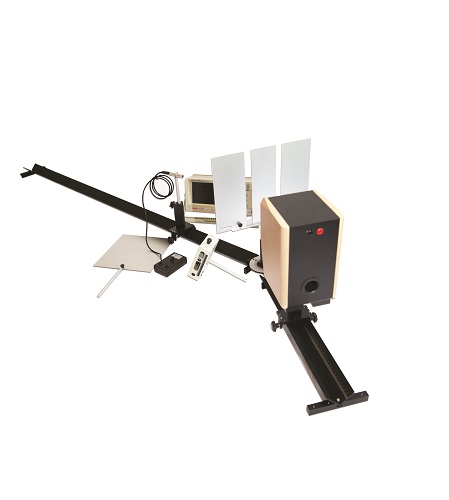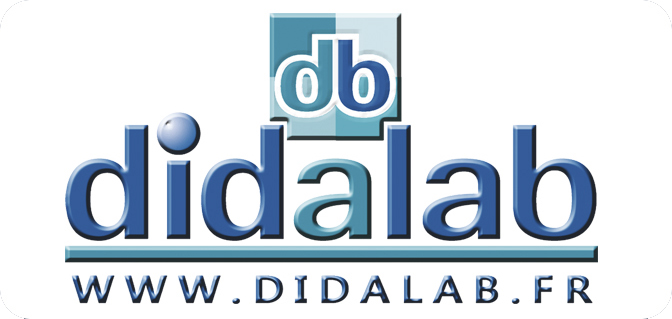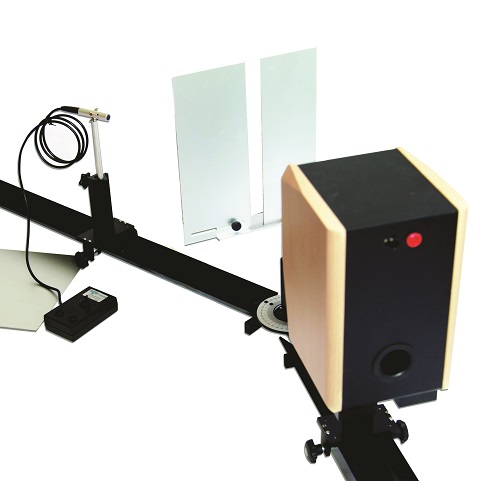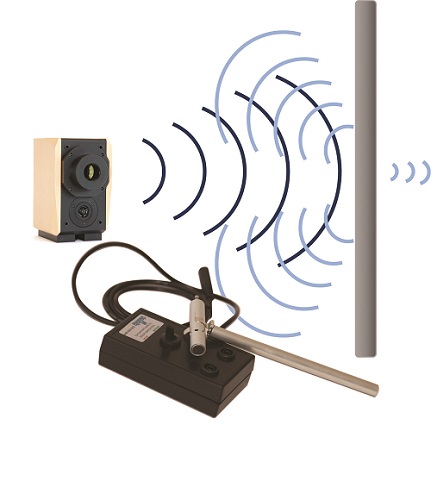Ultrasonic wave study: EXP100100 or EXP100101
Référence : EXP 100 100

An ultrasonic wave is a mechanical vibration propagated in an elastic medium. Its frequency range is between 20 kHz and 1 GHz. It is defined by its wavelength, frequency and propagation speed, which depends on medium density and elasticity.
Their small wavelength confers on them a propagation similar to that of optical waves, thus allowing application of physical optics laws to them. We shall generate ultrasonic waves using an LF function generator and a speaker. Suitable
microphones will be used to receive and analyse these waves. A set of accessories will be available to study the laws of optics (transmission, reflection, diffraction, etc.).
DIFFRACTION VIA A SLIT OR AN EDGE
Diffraction is the behaviour of waves when they encounter an obstacle or an opening. The phenomenon can be interpreted by diffusion of a wave by the object points. Diffraction occurs when, after an encounter with an object, wave density is not preserved. Diffraction is the result of interference of the waves diffused by each point.
When studying wave propagation phenomena, diffraction occurs systematically when the wave encounters an object that obstructs part of its propagation (typically the edge of a wall or a lens). It is then diffracted: diffraction intensity increases progressively as the size of the opening it crosses approaches its wavelength: for example, a radio type wave will be difficult to diffract by buildings in a town. In this case, we shall highlight this phenomenon by means of the variable width slit or just at one of its edges.
REFLECTION
When a sound wave reflects on a surface, part of the wave is absorbed and transmitted in the material, while the rest of the wave is reflected as an optical specular reflection. For solid materials such as wood and metal placed in air, most
of the wave is reflected, roughly 99%, while the tiny remaining percentage is absorbed and transmitted in the material. For porous materials such as foams and sponges, we observe a greater absorption and thus, indirectly, a smaller reflection, as the sound wave loses energy due to the friction force promoted by the porous surface. As a rule, the denser the material, even if it is porous, the more it contributes to increasing reflection of the sound wave.
INTERFERENCES WITH TWO COHERENT SOURCES
For this experiment, we shall use two LF generators, those of the
dual transmitter with a frequency approaching 40 kHz. We can
then, by placing the transmitter on the goniometric platform
and the receiver at the end of the 50 cm bench, implement and
observe a number of situations :
• In phase.
• Varying phase-shift.
• In opposition of phase.
• Different amplitudes.
• Variation in distance between the two sources
SUBJECTS APPROACHED
»»Standing ultrasonic waves
»»Air ultrasonic absorption
»»Diffraction via a single slit or an edge
»»Interferences via a dual slit
»»Determining wavelength
»»Interferences with two coherent sources
»»Reflection
NECESSARY EQUIPMENT
COMPOSITION
EXP100101 Ultrasonic waves (BASIC)
| Reference | Description | quantity | | PHD015615 | Speaker | 1 | | PHD015614 | Dual transmitter, ultrasonic | 1 | | PHD015612 | Microphone | 1 | | PHD015616 | Ultrasonic receiver | 1 | | PED022163 | Slits and multi-slits | 1 | | PED022164 | Metallic screen | 1 | | PBU070300 | "V"-bench with goniometric coupling and 2 riders | 1 |
COMPOSITION
EXP100100 Ultrasonic waves (COMPLETE)
| Reference | Description | quantity | | PHD015615 | Speaker | 1 | | PHD015614 | Dual transmitter, ultrasonic | 1 | | PHD015612 | Microphone | 1 | | PHD015616 | Ultrasonic receiver | 1 | | PED022163 | Slits and multi-slits | 1 | | PED022164 | Metallic screen | 1 | | PBU070300 | "V"-bench with goniometric coupling and 2 riders | 1 | | EMD018015 | Digital oscilloscope, 2x100 MHz | 1 | | PMM062685 | Function generator, 5 MHz, with amplifier | 1 | | PEM010180 | BNC/2x Ø 4 mm cord | 2 | | PEM010021 | BNC/BNC cord, 1 m | 3 | | PED080100 | Set of 2 cords, 1 m (1 red/ 1 black) | 1 | | PEM063960 | BNC "T" adapter: 1 male /2 female | 1 | |
|




